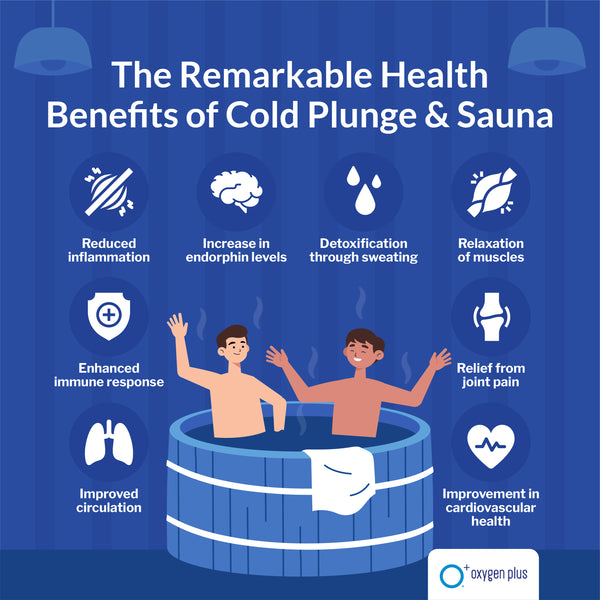Your Cart is Empty
In the depths of freezing temperatures, Wim Hof, famously known as "The Iceman," shattered perceptions of human endurance by staying submerged in ice for 44 minutes. Years later, Valerjan Romanovski broke the world record by staying submerged in ice for three hours and 28 seconds. Their remarkable feats not only captivated the world but also sparked a burgeoning trend in the realm of cold plunges and saunas. Let's explore the rising fascination with these ancient therapies, their incredible health benefits, and how to optimize your experience for maximum wellness.
Wim Hof's extraordinary ability to withstand extreme cold catapulted him to international fame. His techniques, which involve controlled breathing and mental focus, have inspired countless individuals to embrace the icy depths for health and vitality. As interest in holistic wellness surges, cold plunges and saunas have emerged as potent tools for rejuvenation, drawing enthusiasts seeking to invigorate both body and mind.

The allure of cold plunges and sauna sessions goes beyond the thrill of enduring the extremes; they offer tremendous health benefits that are backed by science. Let's delve into the fascinating world of these wellness practices, highlighting not only their benefits but also providing insights into how you can make the most out of your experience.
Cold plunges are not just about the initial shock to the system; they offer long-term benefits that are significant. The benefits of cold plunge include:
The endorphin rush experienced during a cold plunge is often compared to the high obtained from cocaine use, albeit in a completely healthy and non-addictive manner. This comparison is not made lightly; the intense surge of endorphins can help alleviate the need for addictive substances and behavior, providing a natural high that can aid addicts in their recovery process. There are countless stories out there about people who combatted their gambling addiction or cocaine addiction with cold plunge.
On the flip side, saunas offer a soothing yet equally beneficial experience. The benefits of sauna sessions encompass:
Regular sauna use has also been linked to a lower risk of heart disease and even an extension of life expectancy. The best part is that you can combine the benefits of sauna and cold plunge in one session!

To ensure you reap the full rewards of your cold plunge and sauna experience, adequate preparation is key. What follows are some essential tips to help you optimize your session!
A few hours before your session, nourish your body with a balanced meal rich in protein, healthy fats, and carbohydrates. This provides the necessary energy to endure the rigors of cold exposure and heat therapy while supporting muscle recovery afterward. However, make sure you do not go into the sauna and cold plunge feeling full!
Proper hydration is essential for maintaining optimal performance and promoting recovery. Drink plenty of water before, during, and after your session to replenish lost fluids and prevent dehydration. Coconut water or a high-quality electrolyte supplement is an excellent choice after a sauna to replenish your electrolytes.
Incorporating controlled breathing techniques, can help you manage discomfort and regulate your body's response to cold exposure. Practice deep, even, diaphragmatic breathing to calm your mind and enhance resilience.
When immersing yourself in icy waters or basking in the heat of a sauna, prioritize safety above all else. Gradually acclimate your body to extreme temperatures, adhere to recommended exposure times, and listen to your body's cues to avoid overexertion or discomfort. Keep track of time when in the cold water. It may become comfortable after some time but could cause hypothermia. Make sure to not overdo it and always have a buddy present. Listening to your body is crucial; if you feel extremely uncomfortable or in pain, it's time to get out.
Consider enhancing your session with additional tools such as portable oxygen, like Oxygen Plus. Oxygen supplementation can enhance mental clarity and alertness, improve recovery times, and increase overall performance. It can also feel good in your body to take in pure oxygen in the midst of these powerful practices.
Integrating mindfulness and meditation into your cold plunge and sauna routine can amplify the mental health benefits. The focus on breath and presence enhances stress relief and can transform the experience into a powerful meditative practice.
Many of us with the option to heat up in a sauna and then dunk in cold water will do this a few times in a session. If you want to get the most physiological benefits, you should end the cold according to the Soberg principle. By ending a cold, your body heats itself back up naturally, which is where the benefits come from. Also, heating up naturally builds mental resilience as you have to resist the urge to get warm immediately.
Aftercare is as important as preparation. Be sure that the rest of your day doesn’t involve too much movement practice or stress. You just put your body through quite an experience, and now it's time to integrate your experience with rest and reflection. Did you notice any persistent thought patterns? Did you feel a resistance to getting in the cold or to leave the sauna before your body was truly ready? Exploring ideas like this helps us to feel into our mental state and gives us a chance to observe our default mode of thinking, allowing us the chance to make changes that better serve ourselves.
As the allure of cold plunges and saunas continues to captivate wellness enthusiasts worldwide, it's clear that these therapies hold profound potential for enhancing physical and mental well-being. By practicing proper preparation, and integrating essential tools and techniques, you can unlock the transformative power of these ancient practices and embark on a journey to vibrant health and vitality. So, breathe deeply, embrace the chill, and thrive in the exhilarating embrace of cold plunges and saunas.
